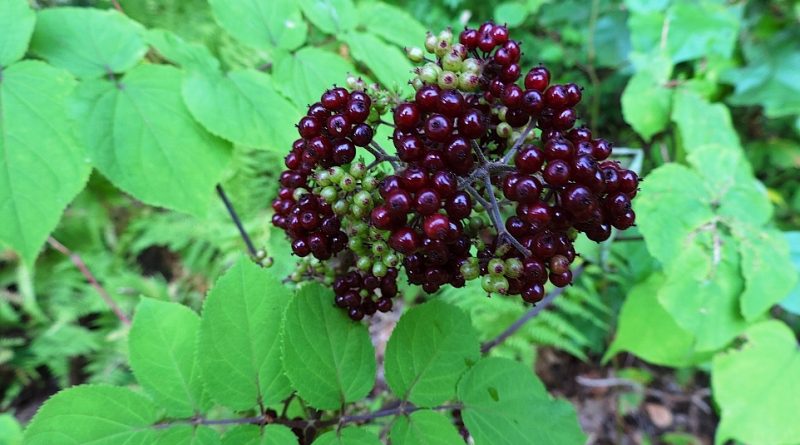Aralia racemosa
Aralia racemosa
American spikenard or Aralia racemosa (Aralia racemosa L.) is a shrub species belonging to the Araliaceae family.
Systematic –
From a systematic point of view it belongs to the Eukaryota Domain, Plantae Kingdom, Tracheobionta Sub-Kingdom, Spermatophyta Superdivision, Magnoliophyta Division, Magnoliopsida Class, Rosidae Subclass, Apiales Order, Apiales Family, Araliaceae Family and therefore to the Genus Aralia and to the species A. racemosa.
The terms are synonymous:
– Aralia racemosa foliose form (Vict. & Rousseau) Scoggan;
– Aralia racemosa var. foliosa Vict. & Rousseau.
Etymology –
The term Aralia comes from aralei, the vernacular name of the plant used by the indigenous people of Canada.
The specific racemosa epithet comes from racémus, bunch, stem: because of the flowers and fruits arranged in the raceme.
Geographical Distribution and Habitat –
The American spikenard is a plant native to North America where it grows in the forests of Canada, Quebec and New Brunswick and the United States, Minnesota and Missouri.
Description –
American spikenard is a plant with a perennial herbaceous shrub bearing that has an aromatic stem and balsamic flavor, very branched, which can reach 100-130 cm in height.
The color of this plant is dark green or reddish.
The root is fleshy and aromatic with a light brown rhizome on the outside and whitish inside.
The leaves are ovate, toothed, very large (up to 50 cm) and of medium intense green color.
The flowers are gathered in umbels located at the axils of the leaves or branches and are greenish in color, while the fruits are berries of green and dark red – purple when ripe.
Flowering is between July and August.
Cultivation –
Aralia racemosa can be grown in the presence of fresh soil, choosing shady and sheltered positions and with a good temperature range between day and night.
The soil must be fertile, rich in organic substances and well drained.
The plant survives at temperatures between -10 and 40 ° C.
It is a plant that if it lives in open ground it must be watered occasionally in the vegetative months, roughly from April to October. If planted in pots, it is necessary to wet regularly from March to October.
As far as pruning is concerned, it does not require any particular techniques except to reduce the volume of the crown for context-related needs. Intervene during rest or after flowering, reducing the vegetation of the previous year by one third. Leave the strongest and healthiest branches.
Uses and Traditions –
Aralia racemosa is a native North American plant widely used both as an ornamental plant but also in some therapeutic applications.
Aralia roots and rhizomes are used which may contain saponins, but no toxicity. Furthermore, there have been no contraindications to normal therapeutic doses, except individual hypersensitivity, although there are no clinical studies that confirm its therapeutic efficacy.
This plant contains saponins, essential oil, resins, tannins and the fundamental active ingredients are: beta-sitosterol; araloside, a triterpene derivative of oleanolic acid.
In general, it is used as a useful remedy in two circumstances: in common or allergic rhinitis, not seasonal, triggered by air currents and in asthmatic syndromes that occur when you lie down or after your first sleep. It is also used to treat rheumatism and certain skin conditions.
In general, the Aralia could act positively for bronchi and bronchioles, gold-pharyngeal cavity, bones, cartilages, joints, respiratory tract and organs of various body districts.
It is in fact a plant with good expectorant and fluidifying power of the mucolytic phlegm and therefore indicated for phlegm, asthma, cough, cold, diseases of the respiratory system and rheumatism.
As with other plants, species rich in saponins are contraindicated in case of lipid malabsorption, deficiency of fat-soluble vitamins, celiac disease, irritation of the gastric mucosa and in the presence of open wounds.
Method of Preparation –
American spikenard is used by preparing a mother tincture using its roots.
Guido Bissanti
Sources
– Acta Plantarum – Flora of the Italian Regions.
– Wikipedia, the free encyclopedia.
– Treben M., 2000. Health from the Lord’s Pharmacy, Tips and experiences with medicinal herbs, Ennsthaler Editore
– Pignatti S., 1982. Flora of Italy, Edagricole, Bologna.
– Conti F., Abbate G., Alessandrini A., Blasi C. (edited by), 2005. An annotated checklist of the Italian vascular flora, Palombi Editore.
Warning: Pharmaceutical applications and alimurgical uses are indicated for information purposes only, they do not in any way represent a medical prescription; therefore, no responsibility is accepted for their use for healing, aesthetic or food purposes.


